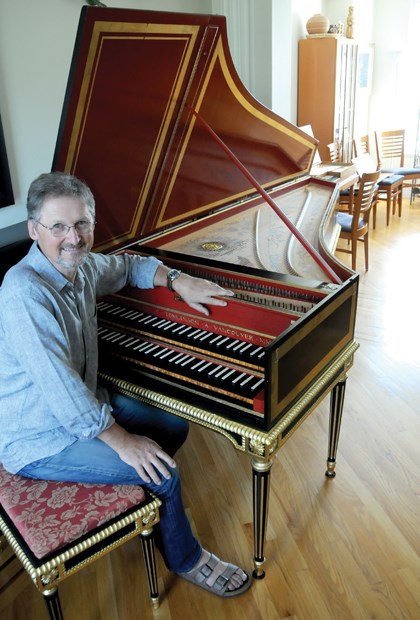Early Music Vancouver presents Henry Purcell's Dido and Aeneas, Thursday, July 30, 7:30 p.m. at UBC's Chan Centre for the Performing Arts. Pre-concert talk at 6:45 p.m. Part of the EMV 2015 Summer Festival. Tickets from $17.50 at chancentre.com or 604-822-2697.
Craig Tomlinson got into harpsichord making while the getting was good.
It was the 1970s. Baroque music was enjoying a revival and period instruments from the 17th and 18th centuries were in high demand.
"That's when harpsichords worldwide were just selling like hotcakes, and luckily I got into harpsichord making right around then and kind of rode that wave," he says.
By that point, Tomlinson had already been making musical instruments for a number of years. In the 1960s, he was into folk music, as many were at the time. He wanted to enhance his instrument collection, but the additions he had in mind weren't readily available in stores - so he decided to make them himself. At age 16, he built his first instrument, an Appalachian dulcimer. As it turned out, he was quite skilled at crafting the fretted, stringed instruments.
"I became so efficient at building dulcimers that it was taking basically less than a week to build each one. I wanted something with a bit more meat on it that I could make into a longer project."
That's when he made the jump from dulcimers, with four strings, to harpsichords, with upwards of 200 strings. He started with factory-produced kits, and after a few years graduated to making his own instruments from scratch.
Today, Tomlinson is a master craftsman of early keyboard instruments that predate the piano, including harpsichords, fortepianos, clavichords and virginals, all of which he makes in his West Vancouver studio. His instruments are used in concert halls around the world by some of the best-known players, ensembles and orchestras and two of his creations will be featured in Early Music Vancouver's firstever presentation of Henry Purcell's baroque masterpiece Dido and Aeneas at the Chan Centre for the Performing Arts on July 30. One of them features a lid painting by Colombian artist Marco Tulio that fittingly depicts the final scene from Purcell's iconic opera.
Worldwide harpsichord sales have tapered off since the 1970s spike, but Tomlinson says demand is still there.
"I think we're still selling a lot of early keyboard instruments, but they're just a lot more diverse, they're not just harpsichords, they're clavichords, virginals and things like that," he says. His buyers include orchestras, individual musicians and private collectors. Some of his creations have also been rented out for use in recording studios and on film sets.
All his instrument designs, materials and structure are based on surviving 17th and 18th century harpsichords from the French, Flemish, Italian and German schools of building. When starting a new project, his first step is to find a template. Both instruments featured at next week's Dido and Aeneas concert, for example, are modelled after a two-manual French harpsichord built in Paris in 1769. Tomlinson visited the original, housed in a collection in Edinburgh, Scotland, and studied it in detail.
"I spent two weeks with the instrument, disassembled it and even took photographs of the inside, and virtually every little measurement was taken that I would need later on in my workshop," he says. "Then I swung down to southern Bavaria where I buy wood and picked up my logs of spruce for the soundboards."
"I basically use all European wood, so the same wood that was used on the originals I'll use those on the copies," he adds. That may be German spruce, yellow poplar, Swiss pear, Italian cypress or European beech, depending on the instrument. That said, some of the "little tiny action parts" involved in plucking the strings are made of local holly. Right now, Tomlinson has some wood that District of West Vancouver arborists pruned from Chatwin Park and dropped off at his nearby studio.
"A holly bush in Paris is almost the same as one in West Vancouver, thank goodness."
Harpsichords are often adorned with elaborate decorations and Tomlinson takes care of all the finishing and gilding. His mother Olga, an accomplished artist who studied with members of the Group of Seven at the Ontario College of Art, paints flowers, birds and other traditional motifs on his soundboards.
The amount of time put into each instrument varies wildly, but Tomlinson estimates a fully decorated harpsichord, minus the lid painting, would take about 1,200 hours to complete. And since he usually has three or four pieces on the go at any given time, those hours may get spread out over the course of a year. Meanwhile, the price of each instrument reflects its size, materials, complexity and esthetic embellishments. A singlemanual Italian harpsichord starts at $27,000, while a French double-manual with a lid painting could run close to $90,000.
"Think of cars," Tomlinson compares. "It's kind of like buying either a compact car or a Mercedes."



